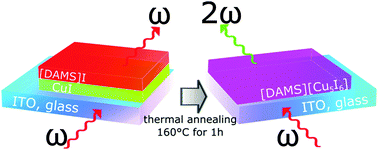Thermal layer-by-layer preparation of oriented films of a Cu(i) ionic inorganic–organic hybrid material showing semiconducting and SHG properties†
Abstract
Inorganic–organic hybrid materials have shown excellent optoelectronic device performances from single-layer solution-processed thin films. Their electronic bands are coupled to the ionic interactions within the organic and inorganic moieties. Exactly these features also allow a sequential deposition route so as to implement thin films having inherently non-linear optical properties perpendicular to the substrate plane. Here, we demonstrate a sequential layer-by-layer path to prepare films of an inorganic–organic hybrid material [DAMS][Cu5I6] through a self-recognition process in the solid state between the first CuI layer and the successive [DAMS]I layer. A persistent non-linear optical behavior, typical of oriented films, is consequently accessible on different substrates without electrical bias poling through the excellent self-recognition of dipoles aligned along the z-axis. In addition, semiconductive and preliminary photovoltaic properties of the film are observed. This work highlights all aspects of the solution-based films with potential to serve as versatile and robust optoelectronic active materials.


 Please wait while we load your content...
Please wait while we load your content...